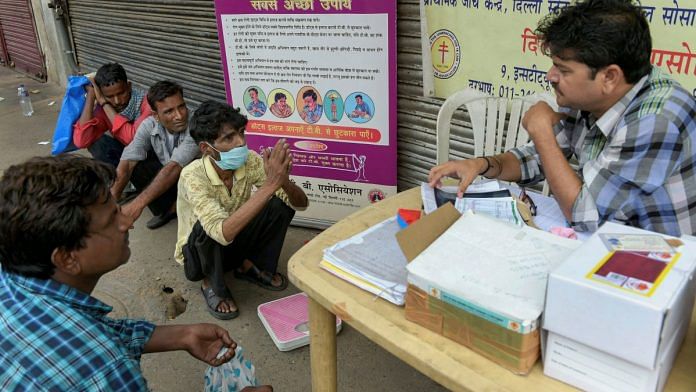Preventable and treatable, yes tuberculosis is both. With this principle in line, the World Health Organization announced the ‘End TB Strategy‘ in 2014, which aims to reduce TB deaths by 95 per cent and the incidence rate by 90 per cent between 2015 and 2035. But, are we on the track to achieve these targets?
The statistics speak otherwise. WHO reports that TB is among the top ten causes of death worldwide and the leading cause from infectious diseases. TB claimed an estimated 1.4 million lives in 2019, including 240,000 among HIV-positive persons. Across the globe, the incidence has fallen by 9 per cent cumulatively between 2015-2019, which is less than half of the End TB Strategy milestone of 20 per cent reduction between 2015 and 2020. The multidrug-resistant TB has emerged as a major health security threat, with a 10 per cent increase in cases in 2019 from the year before. Currently, eight countries account for two-thirds of the new TB cases with India taking the lead over Indonesia, China, Philippines, Pakistan, Nigeria, Bangladesh, and South Africa.
Overview of progress towards the global TB targets


Funding, which is the main sword to fight TB, saw half-empty bags with less than 50 per cent of the funding received for TB research, prevention, diagnosis, treatment and care as against the targets set. How can we strengthen our fight when we know that low- and middle-income countries account for the majority of the cases?
The Covid -19 pandemic further threatens to reverse the progress made against the global burden. The Global Tuberculosis Report 2020 states that the economic impact of the pandemic could worsen two main determinants of cancer incidence – GDP per capita and undernutrition. Two modelling studies suggest that in the aftermath of the Covid-19 pandemic, the progress made to control the disease could be reversed with the annual global TB deaths rising to the levels seen in 2015 or even 2012. The data further suggests that the number of people developing TB could increase by more than one million per year in the period 2020–2025.
As the perennial fangs of TB await to tighten their grip, it’s time to roll up our sleeves and face TB head-on. Multisectoral collaborations clearly hold the imperative to lead the way forward. A mix of biomedical, public health and socioeconomic interventions, combined with research and innovation, will create a portfolio to tackle the menace. However, with the constraints of funding, trained human resources and availability of infrastructure to conduct tests and support TB care and clinical decisions, mainly in low-resource settings, technology or digital health is going to be a torchbearer.
With 8.4 billion people having mobile phones and 47 per cent internet coverage across the globe, mobile health (mHealth) and electronic health (eHealth) can be the real game changer and provide solutions and avenues for action on aspects of TB prevention, care and control. This can come as relief both for the patients in their quest for health and for the health professionals to carry out their work.
The Global Task Force on digital health for TB has identified four functions, namely patient care; surveillance and monitoring; programmatic management; and eLearning wherein Information Communication Technology (ICT) can be tapped. There have been remarkable examples across the globe to prove the success of digital health in each of the above four domains. In Kenya, cash transfers are being done through mobile banking to MDR-TB patients to support their treatment. In Swaziland, health managers can see maps of treatment facilities and infer how they relate to the location of MDR-TB patients and treatment supporter’s home. QuanTB is a software-based programme, which creates a dashboard for drug forecasting and avoids drug stock outs.
Also read: How Covid is making it tougher to tackle TB, AIDS, malaria and child health
A new resolve
Across the world, there are several other initiatives and resolutions that are being taken to seize every opportunity that technology presents to empower people affected by TB and to strengthen the community and health systems, driving the response. Keeping in view the importance of digital health, early this year the ‘Stop TB Partnership, hosted by UNOPS, launched a Digital Health Technology Hub (DHT Hub), a unifying virtual platform that brings together the organisation’s expertise and work in the digital health technology space.
The World Economic Forum’s Centre for Fourth Industrial revolution, India, under its Health Project – Fourth Industrial Revolution for Sustainable Transformation of Healthcare (FIRST) will also be working with a coalition of partners from government, academia, industry and civil society to conceptualise evidence-based implementation and impact measurement frameworks to deploy emerging technologies like artificial intelligence, machine learning and blockchain in early detection, patient adherence and TB care in India.
It is time to catapult the TB response on the fulcrum of technology throughout the TB cascade of care not only to maintain essential TB services, but also to improve TB case detection, adherence to treatment and treatment outcomes.
The theme of the World TB Day 2021 – ‘The Clock is Ticking’ – conveys the sense that the world is running out of time to act on the commitments to end TB made by global leaders. The WHO’s ‘End TB Strategy’ gave us a vision, we should now have a firm resolve to transform our commitments into actions.
Dr Ruma Bhargava is Lead Healthcare, World Economic Forum. Views are personal.
(Edited by Prashant Dixit)






